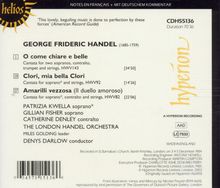Georg Friedrich Händel: Kantaten auf CD
Kantaten
Herkömmliche CD, die mit allen CD-Playern und Computerlaufwerken, aber auch mit den meisten SACD- oder Multiplayern abspielbar ist.
O Come chiare e belle; Clori, mia belle Clori; Amarilli Vezzosa
Die Musik sprüht nur so vor geistreichen Einfällen. Eine kurze und bündige Eröffnungssonata leitet direkt über in Olintos erste Arie; das Bild des im Licht des „milden Stern“ schimmernden Tibers wird durch zarte, einander überlappende Violinfiguren evoziert. Das Erwachen des Tibers („Chi mi chiama?“) wird von einer punktierten Basslinie begleitet, die Händel später noch einmal in der Oper Alcina verwendete, und die folgende, lebhafte Arie in g-Moll („Più non spera“) wurde zurecht für Il Pastor Fido wiederbelebt. Die erste Äußerung der Gloria ist überraschenderweise eine langsame Arie mit einer ungeheuer verzierten Vokallinie, in der sie Rom für seinen traurigen Zustand leise tadelt. Der Glanz kehrt jedoch mit „Tornami a vagheggiar“ zurück, wo die strahlende Melodie zum ersten Mal erscheint, die durch die Arie aus Alcina, die mit denselben Worten beginnt, wohl am berühmtesten geworden ist. (Die Ritornelli kehren in der Arie „E pur bello“ in Teseo wieder.) Die nächste Arie Olintos bezieht sich auf den Kriegsalarm, der die Helden des alten Roms erregte. Um jedoch den Höhepunkt nicht vorwegzunehmen, arbeitet Händel hier nicht mit den üblichen Stilmitteln, sondern setzt das Stück als formelles Menuett. Nachdem Gloria den „milden Stern“ geradezu ekstatisch gelobt hat, erklärt Olinto, dass er seine Schäfer-Flöten gegen eine Kriegstrompete eintauschen will. Händel fügt der letzten Arie eine richtige Trompete hinzu, was einen brillanten Effekt hat. Das Werk endet mit einem kurzen coro der drei Sänger.
Product-Information:
The music is full of spirited invention. A brisk and brief opening sonata leads directly into Olinto’s first aria; the image of the waters of the Tiber shimmering in the light of the ‘clement star’ is evoked by delicate overlapping figures in the violins. The Tiber’s awakening (‘Chi mi chiama?’) is accompanied by a bass line in dotted rhythm which Handel later put to good use in Alcina, and the vigorous G minor aria that follows (‘Più non spera) was rightly rescued for Il Pastor Fido. Glory’s first utterance is, surprisingly, a slow aria with a highly embellished vocal line, gently rebuking Rome for its dejected state. Brilliance returns in ‘Tornami a vagheggiar’, which marks the first appearance of the radiant tune best known from the aria in Alcina beginning with the same words. (The ritornellos were used for the aria ‘E pur bello’ in Teseo.) Olinto’s next aria refers to the alarms of war arousing Rome’s ancient heroes, but to avoid anticipating his climax Handel declines to use the obvious imagery and sets it as a formal minuet. After Glory has ecstatically praised the ‘clement star’ Olinto declares he will change his shepherd’s pipes for the trumpet of war and, with splendid effect, Handel adds a real trumpet to the score for the final aria. A brief coro for the three singers concludes.
Rezensionen
'beautifully performed' (New York Times)
'enjoyable performances ... well worth exploring' (Gramophone)
Disk 1 von 1 (CD)
O come chiare e belle HWV 143 (für 2 Soprane, Alt, Trompete und Streicher) (Kantate)
-
1 Arie: O come chiare e belle
-
2 Rezitativ: Ma quel che più
-
3 Arie: Chi mi chiama
-
4 Rezitativ: Dell'arcadi foreste
-
5 Arie: Più non spero
-
6 Rezitativ: Per te non più rubella
-
7 Arie: Caro Tebro
-
8 Rezitativ: Si, la Gloria
-
9 Arie: Tornami a vagheggiar
-
10 Rezitativ: Tebro, tu no rispondi?
-
11 Arie: Al suon che destano
-
12 Rezitativ: Di stupor, di diletto
-
13 Arie: Io torno a sperare
-
14 Rezitativ: Di si giuste speranze
-
15 Arie: Astro clemente
-
16 Rezitativ: Tebro, ti dissi il vero
-
17 Arie: Alle voci del bronzo guerriero
-
18 Trio: Viva, viva!
Clori, mia bella clori HWV 92 (für Sopran und Streicher) (Kantate)
-
19 Rezitativ: Clori, mia bella clori
-
20 Arie: Chiari lumi
-
21 Rezitativ: Temo, ma pure io spero
-
22 Arie: Ne gigli e nelle rose
-
23 Rezitativ: Non è però che non molesta
-
24 Arie: Mie pupille
-
25 Rezitativ: Tu nobil alma intanto
-
26 Arie: Di gelosia il timore
Amarilli Vezzosa HWV 82 (für Sopran, Alt und Streicher) (Kantate)
-
27 Sonata
-
28 Rezitativ: Amarilli vezzosa
-
29 Arie: Pietoso sguardo
-
30 Rezitativ: Dunque tanto s'avanza
-
31 Arie: Piacer che no si dona
-
32 Rezitativ: Si, si, crudel
-
33 Arie: Quel nocchiero che mira le sponde
-
34 Rezitativ: Amarilli, Amarilli
-
35 Arie: E vanita d'un cor
-
36 Rezitativ: Or su, già che ostinato
-
37 Duett: Si, si, lasciami ingrata
Mehr von Georg Friedrich...
-
Georg Friedrich HändelAcis und Galatea (1718)2 CDsVorheriger Preis EUR 24,99, reduziert um 0%Aktueller Preis: EUR 9,99
-
Georg Friedrich HändelConcerti grossi op.3 Nr.1-6CDVorheriger Preis EUR 17,99, reduziert um 0%Aktueller Preis: EUR 7,99
-
Gloria Dresdensis - Orchesterwerke aus DresdenCDVorheriger Preis EUR 17,99, reduziert um 0%Aktueller Preis: EUR 7,99
-
Georg Friedrich HändelImeneo2 CDsAktueller Preis: EUR 14,99








